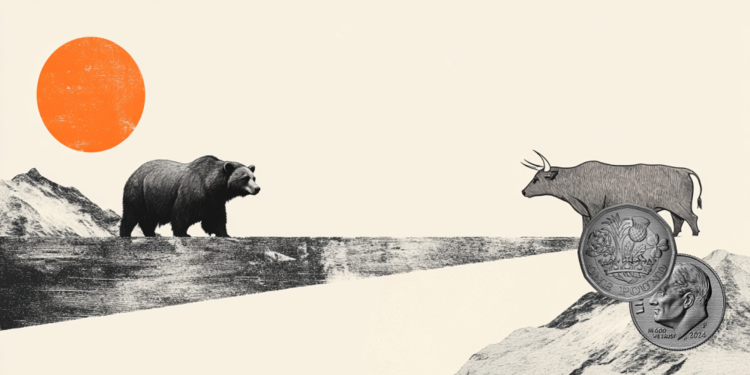There are two Michael Jordans, both widely regarded as the Greatest of All Time. One is an NBA legend. The other is a pumpkin. In 2023, the 2,749-pound Goliath set the world record for heaviest pumpkin. Michael Jordan weighed as much as a small car and was even more massive—so broad that it would just barely fit in a parking space. Like all giant pumpkins, its flesh was warped by all that mass—sort of like Jabba the Hutt with a spray tan.
It is hard to imagine how a pumpkin could get any bigger. But you might have said the same thing about the previous world-record holder, a 2,702-pound beast grown in Italy in 2021, or the world-record holder before that, a Belgian 2,624-pounder in 2016. Each year around this time, giant pumpkins across the globe are forklifted into pickup trucks and transported to competitions where they break new records.
Michael Jordan set the record at California’s Half Moon Bay Safeway World Championship Pumpkin Weigh-Off, considered the Super Bowl of North American pumpkin-growing. The first winner of the competition, in 1974, weighed just 132 pounds. In 2004, the winner clocked in at 1,446 pounds. “At that time, we thought, Gee whiz, can we push these things any farther?” Wizzy Grande, the president of the Great Pumpkin Commonwealth, an organization that establishes global standards for competition, told me. Yet in just another decade, the record passed the 2,000-pound mark. “We’ve zoomed past that now,” Travis Gienger, the grower from Minnesota who cultivated Michael Jordan, told me. For champion growers, there’s only one thing to do next: try to break 3,000.

Giant pumpkins aren’t quite supersize versions of what you find in the grocery store. All competitive pumpkins are Curcubita maxima, the largest species of squash—which, in the wild, can grow to 200 pounds, about 10 times heavier than the common Halloween pumpkin. But decades of selective breeding—crossing only the largest plants—has created colossal varieties.
Virtually all of today’s champions trace their lineage to Dill’s Atlantic Giant, a variety bred in the 1970s by a Canadian grower named Howard Dill. Very competitive growers source their seeds from one another, through seed exchanges and auctions, where a single seed can be sold for thousands of dollars, Michael Estadt, an assistant professor at Ohio State University Extension who has cultivated giant pumpkins, told me. Seeds from Gienger’s champions are in high demand, yet even he is constantly aiming to improve the genetics of his line. “I’m looking for heavy,” he said.
Yet even a pumpkin with a prize-winning pedigree won’t reach its full size unless it’s managed well. Like babies, they require immense upkeep, even before they are born. Months before planting, at least 1,000 square feet of soil per pumpkin must be fertilized and weeded. Once seedlings are planted, they have to be watered daily for their entire growing period, roughly four months. No mere garden hose can do the trick; each plant needs at least one inch of water a week, which allows the pumpkin to gain up to 70 pounds in a single day. The fruit and leaves must also be inspected at least once daily for pests and disease—no small feat as their surface area balloons. Quickly spotting and excising the eggs of an insect called the squash-vine borer, then bandaging the wounded vine, is paramount. One day, you might have a great pumpkin, “then boom, the next day, all of the vine is completely dead,” says Julie Weisenhorn, a horticulture educator at the University of Minnesota who has grown giant pumpkins—named Seymour (744 pounds) and Audrey (592 pounds).
Growers can keep pushing the pumpkin weight limit by ensuring that a plant isn’t pollinated by a variety that has subpar genes. To do so, they hand-pollinate, painstakingly dusting pollen from a plant’s male flowers into the female ones. This usually leads the plant to bear three or four fruit, but only the most promising is allowed to survive. The rest are killed off in an attempt to direct all of the plant’s resources toward a single giant. In the same vein, wayward vines are nipped, and emerging roots thrust deep into the ground, in hopes of harnessing every last nutrient for the potential champion.
Still, some factors are beyond anyone’s control. The weather can literally make or break a pumpkin. Too much rain can cause a pumpkin to grow too quickly, cracking open its flesh, which would disqualify it from competition. Too much sunlight hardens the flesh, making it prone to fractures. It’s not uncommon for giant pumpkins to have custom-built personal sunshades. North America’s giant-pumpkin capitals—Half Moon Bay, Nova Scotia, and Minnesota—have nature on their side, with low humidity and nighttime temperatures. Cooler nights mean less respiration, which means less wasted energy.
Yet nature bests even the world’s champions. This year, Gienger couldn’t break the record he set with Michael Jordan; he blames cold and wet weather, which made it harder to feed micronutrients to his pumpkin, Rudy. (At 2,471 pounds, it still won the Half Moon Bay competition.) And no matter how big a pumpkin grows, it needs to pack a few extra pounds for the road: Once they’re cut from the vine, they rapidly lose their weight in water. A pumpkin can drop roughly 10 pounds in a single day.
All of the experts I spoke with believe that 3,000 pounds is within reach. “It’s still an upward trend,” said Grande, who noted that a 2,907-pounder has already been recorded, albeit a damaged one. Pumpkin genetics are continually improving; more 2,000-pounders have been grown in the past year than ever before, according to Grande. Growers are constantly developing new practices. Each year, the Great Pumpkin Conference holds an international summit for growers and scientists to trade techniques (last year’s was in Belgium, and this year’s will be in the Green Bay Packers’ Lambeau Field). Shifting goals have precipitated new (and expensive) methods: Carbon dioxide and gibberellic acid are being used as growth stimulants; some pumpkins are fully grown in greenhouses.
The reason that giant-pumpkin weights increased 20-fold in half a century is the same reason that runners keep running faster marathons, that skyscrapers keep clawing at the sky, and that people spend so much on anti-aging. To push nature’s limits is a reliably exhilarating endeavor; to be the one to succeed is a point of pride. Food companies, in particular, build their entire businesses on developing the biggest and best. Wild strawberries are the size of a nickel, but domesticated ones are as huge as Ping-Pong balls. Industrial breeding turned the scrawny, two-and-a-half-pound chickens of the 1920s into today’s six-pounders. There’s still room for them to grow: Strawberries can get as big as a saucer, and the heaviest chicken on record was a 22-pounder named Weirdo. But foods sold commercially are subject to other constraints on growth, such as transportation, storage, processing, and customer preference. Unusually big foods are associated with less flavor, and their size can be off-putting. When it comes to food, there is such a thing as too big.
Giant pumpkins, by contrast, have a singular purpose: to become as heavy as possible. They don’t have to be beautiful, taste good, or withstand transport, because they are not food. When companies develop boundary-pushing crops and animals, that tends to be an isolationist enterprise, shrouded in secrecy. But in the giant-pumpkin community, there is less incentive to guard seeds and techniques. Most competitions are low-stakes local affairs, and nobody ever became rich off giant pumpkins, not even Howard Dill.
Breaking records is largely seen as a communal effort. “The secret to our success is that we are a sharing community,” Grande said. In a few contests, the investment is worth it—the Half Moon Bay prize for world-record-breakers is $30,000—but “it’s not a get-rich-quick scheme,” Estadt told me. People do it, he said, “for the thrill of the win.”
All of the pumpkin experts I spoke with acknowledged that there must be a limit. But nobody has any idea what it is. Four thousand pounds, 5,000—as far as growers can tell, these are as feasible as any other goal. Every milestone they reach marks another human achievement, another triumph over nature. But even the most majestic of pumpkins inevitably meets the same fate: devoured by livestock, and returned to the earth.







